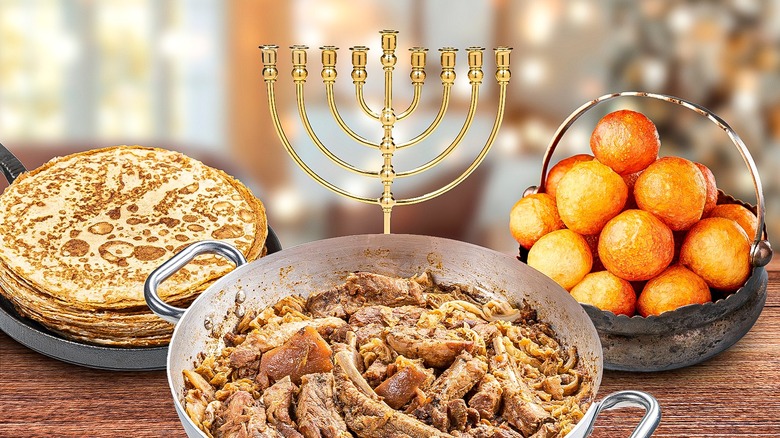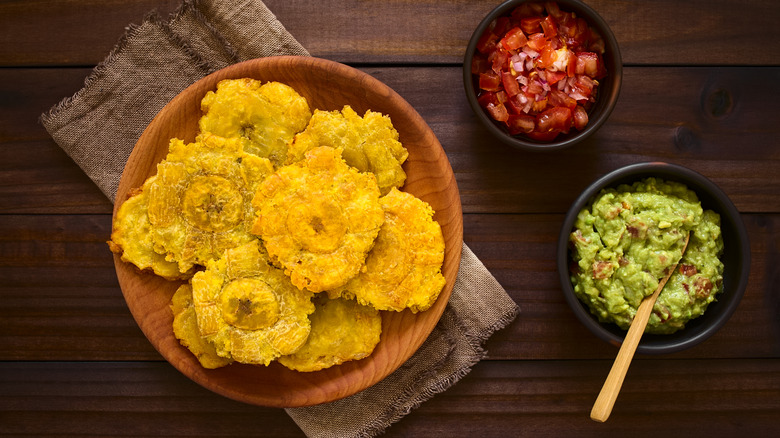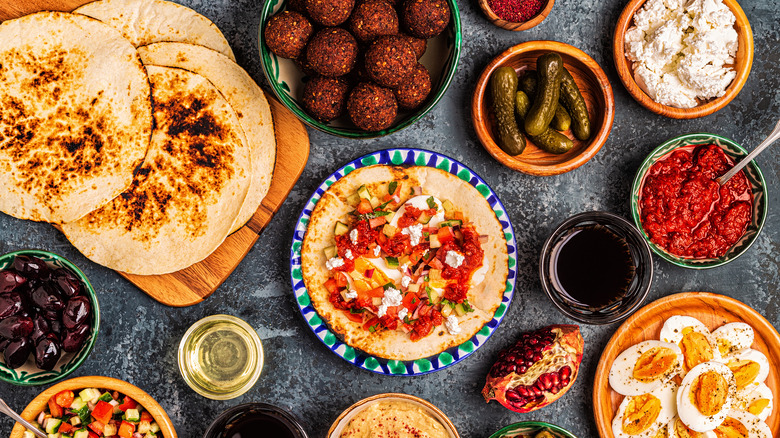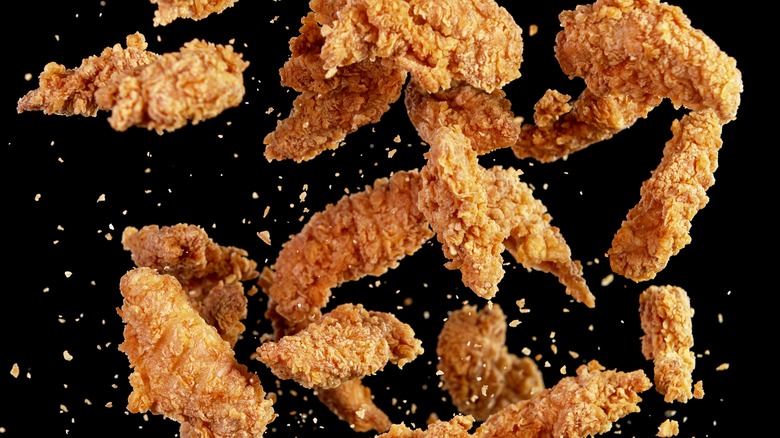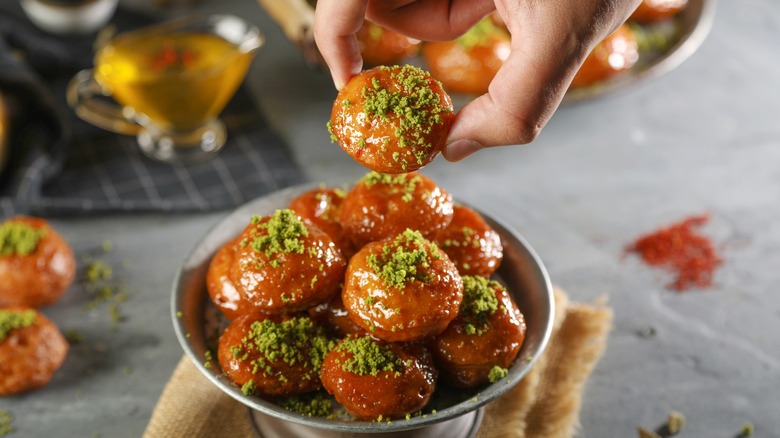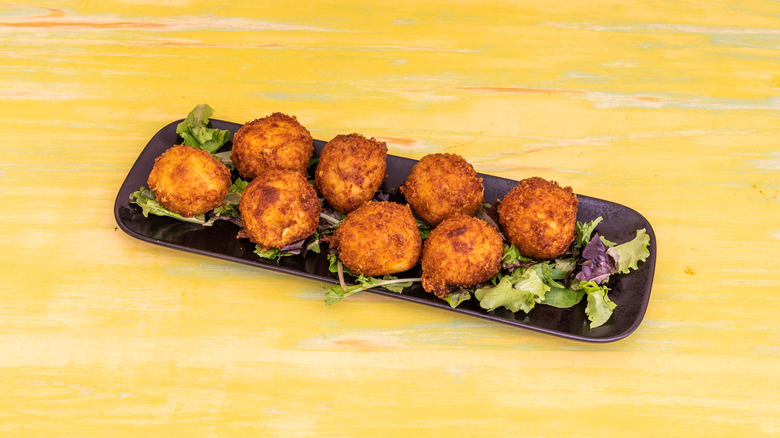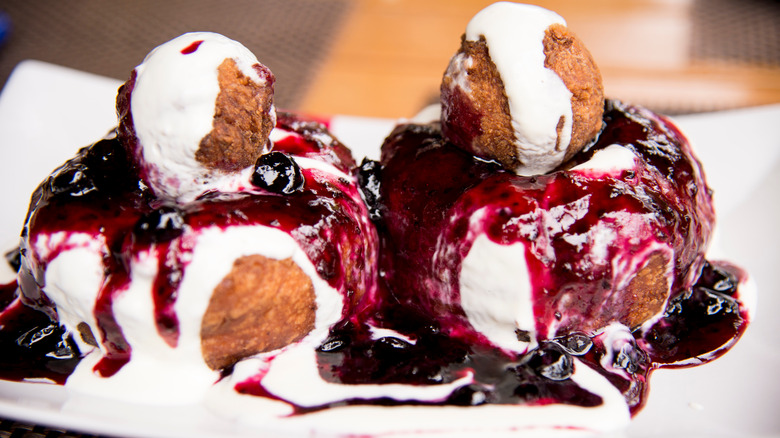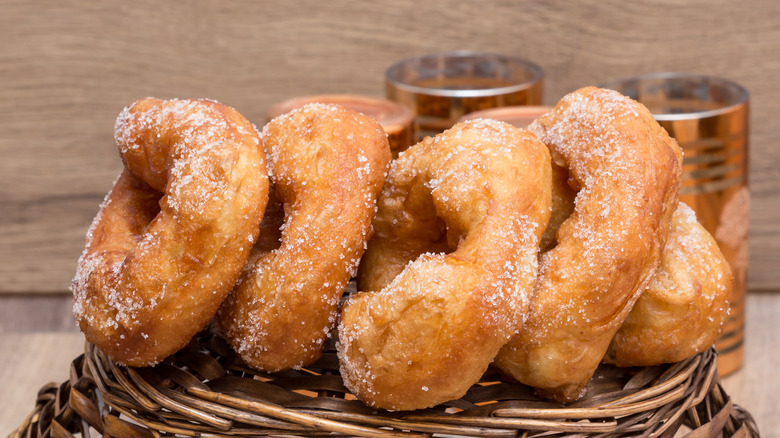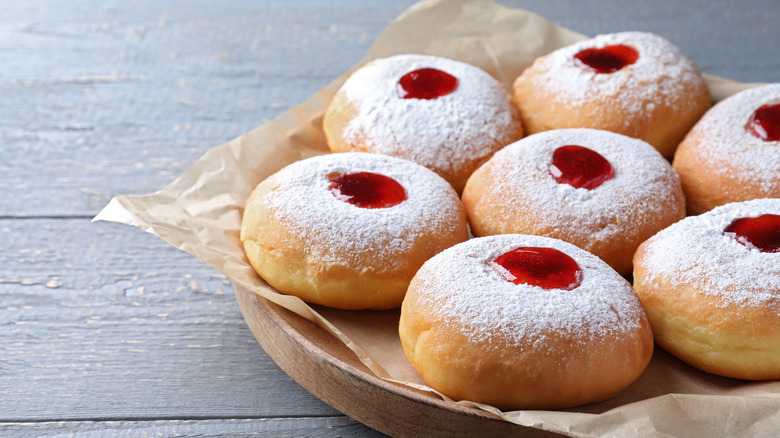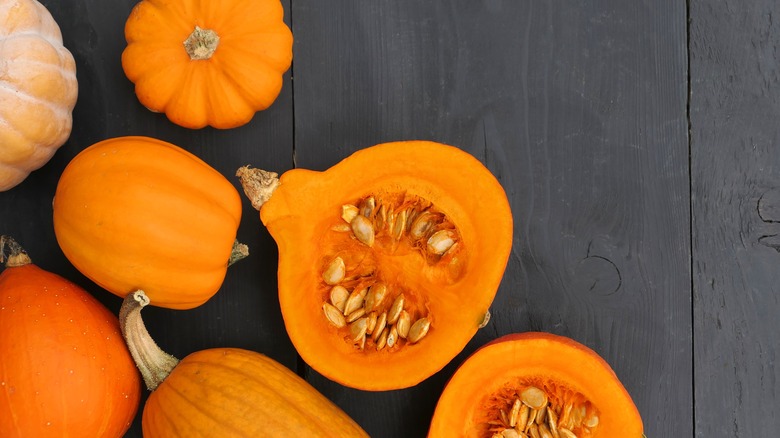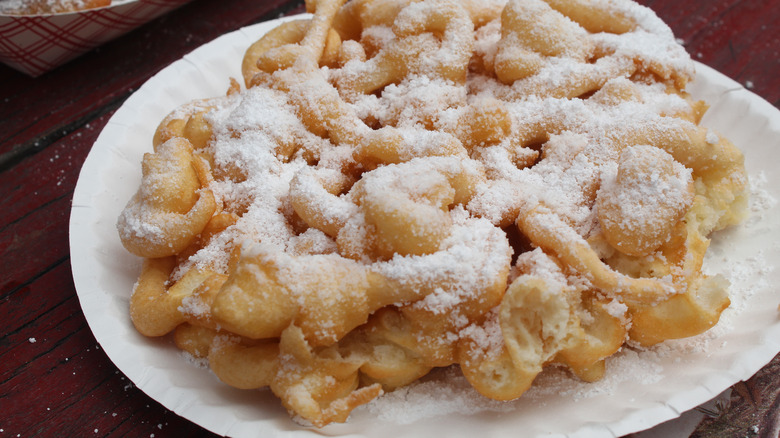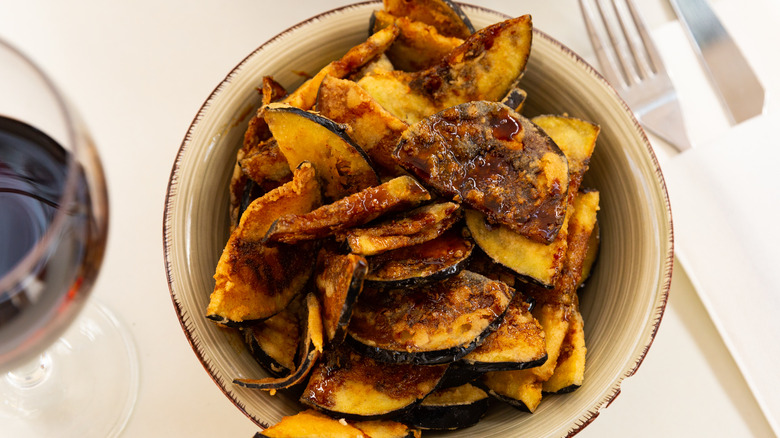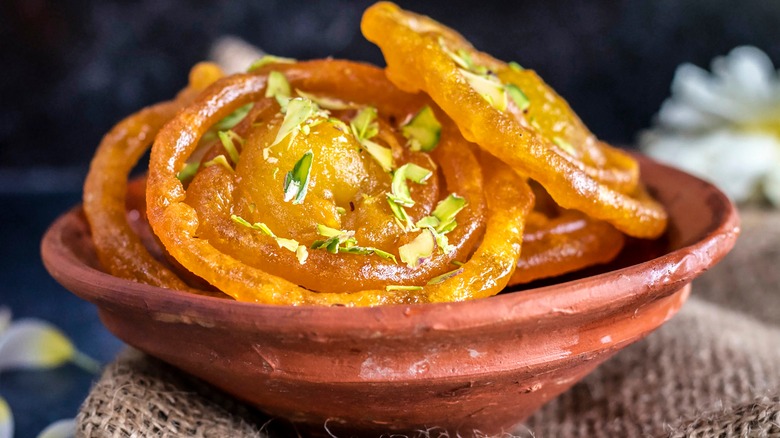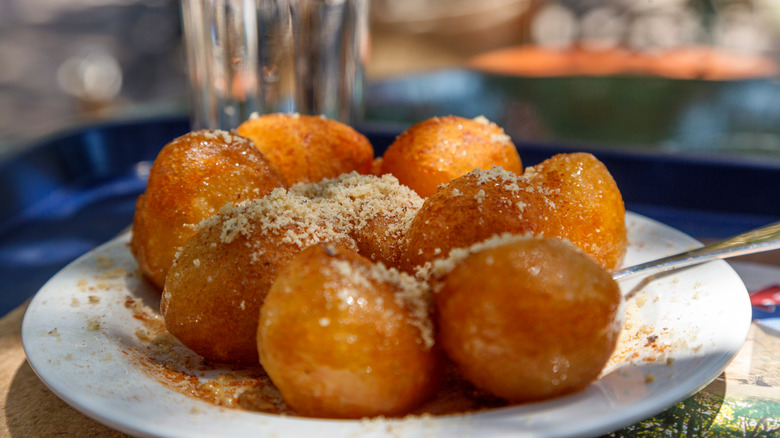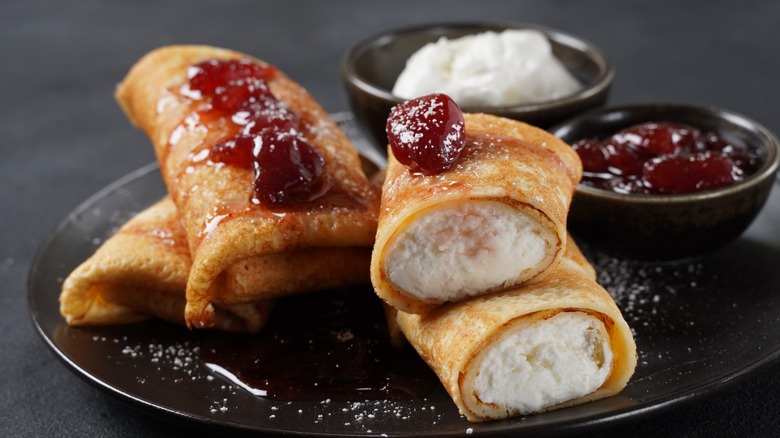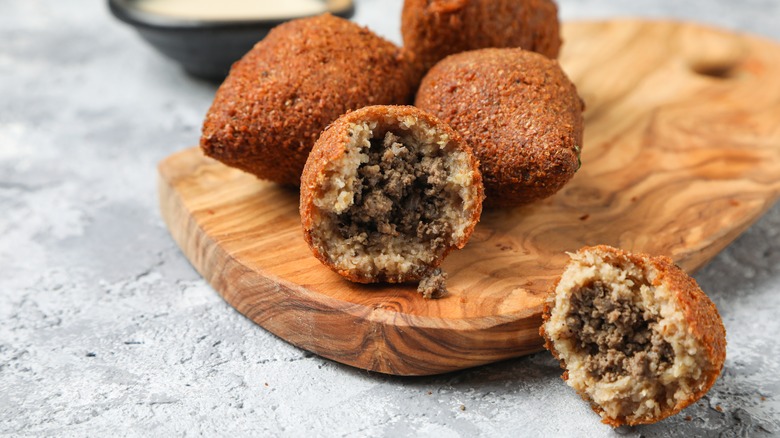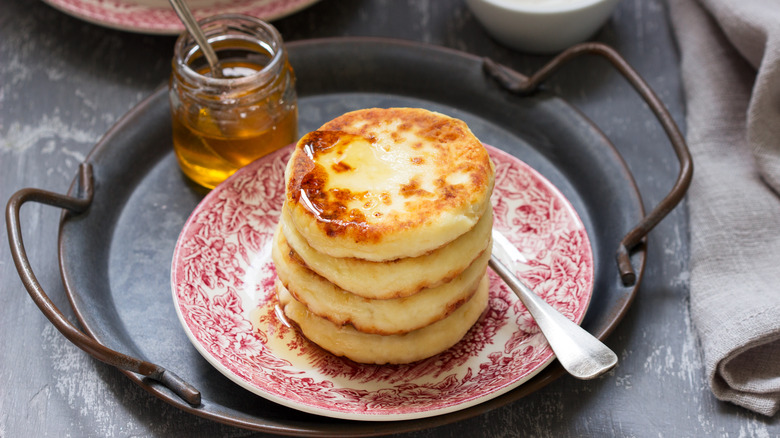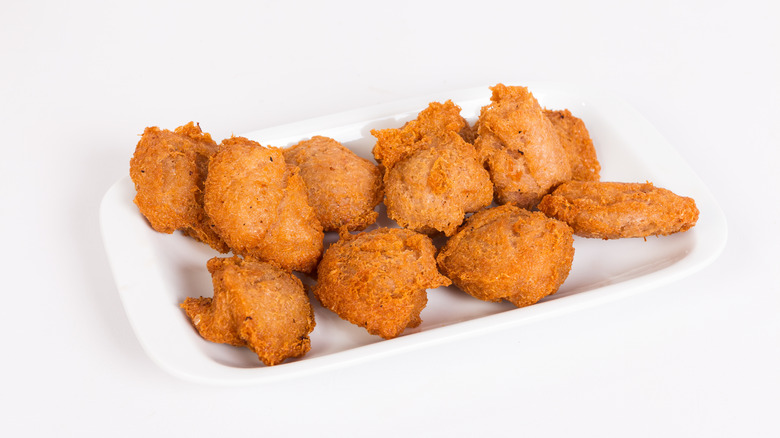17 Hanukkah Foods From Around The World
Hanukkah, the eight-day Jewish festival of lights, is a great one for food. The holiday is a less significant one within Jewish culture, commemorating the scrappy Jewish army known as the Maccabees and their quest to gain religious freedom from the Greek Syrians. More importantly, it honors the resilience and power of the human spirit and the triumph of good through the metaphor of oil. Oil found in the synagogue which had been decimated during battle had been predicted to last for one night but burned miraculously for eight, keeping the newly reclaimed temple's eternal flame alight and the spirits of the Jewish people burning brightly.
During the celebration of Hanukkah, oil plays a large feature in the foods eaten in celebration, so it's no surprise that fried foods are a common theme. Though potato latkes are as delicious as they are prevalent amongst Ashkenazi (Eastern European) Jewish communities, there's so much more to Hanukkah foods than just latkes. From plantains to eggplant to doughnuts, here are foods eaten around the world to celebrate the holiday.
Cuba and Puerto Rico — Tostones
Plantains often take the place of the potato in countries like Cuba and Puerto Rico, so it is not unusual to see tostones, a crispy deep-fried chip made from slices of slightly green or unripe plantain in place of a potato latke. Plátanos fritos — a similar, though sweeter, chip — can be made using ripened plantains as well.
Green plantains are starchy and provide a very similar texture to potatoes. For The Nosher, chef and author Jennifer Stempel celebrates her Jewish/Cuban heritage by demonstrating how her family, with Cuban origins, makes tostones for Hanukkah.
That said, you don't need an oil-soaked holiday for a good excuse to make a batch of tostones. Provided you have access to plantains — which are not to be confused with bananas — they can be eaten any day of the week you choose, and make a wonderful snack, accompanied by a cold drink, to share with friends.
Yemen — Malawach
Until fairly recently, there has been a vibrant Jewish community in Yemen, dating back to at least the 3rd century; some say it can be traced all the way back until biblical times. In 1949, most of this community — over 40,000 people — emigrated to Israel in what was later referred to, albeit problematically, as "Operation Magic Carpet."
This long-standing community over time created a Jewish culture, with many unique and delicious baked goods made to celebrate Shabbat (the Jewish day of rest) as well as other holidays throughout the year. Malawach is one such bread. It's made from a laminated dough enriched with butter, which is rolled into rounds and fried in oil, resulting in a flaky, rich flatbread perfect for dipping or scooping up the remains of any ingredient or sauce at any time of day.
Given the migration of the Yemenite Jewish community to Israel, it is no surprise that this dish has also become popular there, too, often served alongside fresh tomatoes, hummus, eggs, or zhug (hot sauce). It fits the requirement of being deep fried in oil to commemorate Hanukkah but can — and should — be eaten year-round.
Italy — Pollo Fritto di Hanucca
Olive oil is a central tenet of Italian cuisine, so you likely don't need the excuse of a holiday to convince Italian Jews to break out the good stuff. Italy is a country rich with olive tree groves and the perfect climate for producing some of the world's finest.
As author and cook Joyce Goldstein writes in her book "Cucina Ebraica: Flavors of the Italian Jewish Kitchen," latkes aren't particularly popular among Italian Jews. Throughout the eight nights, foods from pumpkin to artichokes will be deep-fried in rich Italian olive oil, including pollo fritto di Hanucca, which is marinated chicken which is dredged in egg and flour and fried until crispy.
Pollo fritto di Hanucca makes for a complete meal when served alongside more fried things like stuffed and fried gnocchi, fritelle di patate, deep-fried vegetables, or even deep-fried olives. When it comes to Italian olive oil during Hanukkah, there's just no such thing as too much.
Egypt — Zalabia
Ingredients and recipes, like people, are never stagnant; they are known to travel and explore new countries and communities, changing as they go. Often too, different communities within one region will make similar versions of the same dish, each for their own cultural celebrations or traditions. Such is the case with zalabia and the Jewish and Muslim communities of Egypt.
As chef Nir Mesika explains to the Jewish Food Society, his family learned how to make zalabia — ping pong-sized balls of dough deep fried in oil and then drenched in honey — thanks to his Egyptian grandparents' Muslim neighbors, who made the dish during Ramadan. Rather than Egypt, Mesika grew up in Haifa, Israel before settling in New York City, bringing the dish and its mixed origins with him. Zalabia is often a celebratory dish within both Muslim and Jewish communities — one that can be made for many holidays, including Hanukkah.
Some stories and scholars pinpoint the Egyptian dish's origins to the Sephardic Jews in Al-Andalus (or Spain and Portugal as we now know it), arriving in Egypt alongside the Jewish communities fleeing the Spanish Inquisition. Despite the many postulations of the dish's origin, it's safe to say this deep-fried dish is deeply loved by many from this region, regardless of background.
Mexico — Croquettes
Jewish communities have been calling Mexico home since the 17th century. However, many were not able to celebrate their religious beliefs openly until the 1900s, after which there was an influx of Jewish refugees seeking religious freedom.
As of 2010, there were an approximated 67,000 Jews in Mexico, largely of Sephardic descent and residing in Mexico City. Hanukkah celebrations in these Jewish Mexican communities will often include a variety of deep-fried croquettes, incorporating ingredients like ricotta, brisket, fish, and black beans.
Jewish Mexican chef and proprietor Julian Medina of Tolache is known for incorporating Jewish sensibilities into his own Mexican-inspired foods and vice versa after converting to Judaism. Tolache's previous menus have included latkes with jalapeños or Mexican cheeses, brisket tacos, and more.
Los Angeles-based Japanese Mexican chef Katsuji Tanabe offers his Jewish customers deep-fried burritos and brisket carnitas during Hanukkah, combining Mexican and Jewish food customs. Tanabe told Forward that since Mexican cuisine regularly enriches food with oil, connecting it to Hanukkah feels natural.
Romania — Papanasi
For Jewish communities celebrating Hanukkah in Romania, papanasi (pronounced "papranash"), a deep-fried curd cheese-filled doughnut topped with cherry jam and sour cream, is on the menu.
Papanasi is a widely celebrated Romanian and Moldovan dish, enthusiastically consumed year-round by all Romanians. Papanasi are often filled with urda, a traditional unpasteurized soft curd cheese made from goat's, sheep's, or cow's milk, commonly found in Eastern European countries. They can also be made with ricotta.
It was soft curd cheeses like ricotta and urda that were first made into latkes, until the potato had made its way from the Americas across to Europe in the 13th century. Not only do these traditions remain in Romania, but cheese-filled latkes are also commonly found in Italy, known for its ricotta.
Papanasi have a distinctive look that Nomad Paradise refers to as a "fat fried snowmen" shape, due to their traditional cooking technique of putting together two deep-fried spheres together before drizzling them with lashings of sour cream and sour cherry jam. The flavor profile mirrors another Jewish food you need to try: blintzes. It's no wonder this decadent dessert has remained so popular over time.
Morocco — Sfinj
Food historian Emelyn Rude credits North African Jewish merchants for bringing the sfeni (or sfinj) to Europe. The original, home-cooked version of the popular, often over-the-top sufganiyot has become widely popular in Israel. Sfinj are a well-loved homemade treat for North African Jewish families and are enjoyed by Jewish communities in Libya, Algeria, and Tunisia as well.
Sfinj are known for being relatively simple to make compared to sufganiyot. They're ring-shaped, deep-fried doughnuts that require little fuss as they are not traditionally filled, unlike their higher-maintenance deep-fried cousin. Once cooked they can then be enjoyed sweetened, either simply by dipping them into honey or sprinkling them with sugar.
According to the Jewish Telegraphic Agency, nearly half of Israelis are now of Mizrahi descent, meaning Middle Eastern or North African. This too, explains the increasing popularity and rise in a variety of North African dishes within Israeli cuisine and popular culture, including the making of sfinj during Hanukkah celebrations as backgrounds and origins become increasingly blurred, overlapped, and celebrated in tandem.
Israel — Sufganiyot
In his book "Encyclopedia of Jewish Foods," the late food writer Gil Marks wrote that one of the reasons why sufganiyot became a marker of Hanukkah traditions in Israel was due to an increase in jelly doughnut manufacturing. This was a strategic move, designed to boost the economy and reduce the labor-intensive task of creating these foods at home, in what was then Palestine in the 1920s. By manufacturing the product around Hanukkah, many Jewish workers benefited from the paid work, which simultaneously reduced the effort required to produce such goods at home. As a result of this industrial and economic boost, a report in 2018 showed a staggering 20 million sufganiyot are consumed in Israel during Hanukkah.
Sufganiyot culture in Israel has absolutely exploded, with blog posts like Debbest Israel featuring a guide to finding the best in Jerusalem, and other articles suggesting the best wine pairings to accompany the deep-fried doughnut. If you're interested in trying this incredibly popular food but can't quite make it to Israel to do so, why not try making your own spiced sufganiyot; whatever wine you have in the fridge or cupboard to have with it is fine by us.
Sephardic Bimuelos de Kalavasa
Pumpkin or squash, called kalavasa, has been a part of Sephardic Jewish food culture around the world from Spain to Turkey to India. Because of its meaty-yet-vegan status and its adaptability, it has been invaluable in helping to keep with kosher dietary laws in certain areas of the world; thankfully there are plenty of ways to cook with pumpkin, too.
Pumpkin is often eaten symbolically as many foods are for Rosh Hashanah, which is the Jewish New Year. It can also be used in soups, stews, curries, and as filling in pastries. Across many Sephardic groups that span the globe, pumpkin is added to batters to make deep-fried food like pancakes or bimuelos during the celebration of Hanukkah. In Syria, this dish is known as "kibbet yatkeen." Lemon, rose, and orange blossom water are used to flavor bimuelos depending on where they are being made. We can think of no better or more delicious excuse than Hanukkah to put together a bimuelo feast, with every type and flavor represented.
Iraq — Zengoula
Zengoula is a deep-fried traditional Iraqi dish, similar to a funnel cake, accentuated by honey, sugar syrup, powdered sugar, or, as Jewish Iraqi food writer Amelia Saltsman suggests, a lemon-infused syrup to help create balance. Though it can be made for many different occasions, it is also often eaten by Jewish Iraqi communities as part of Hanukkah festivities.
Zengoula is so delicious it's known for having traveled the world, proving that humankind has a universal weakness when it comes to resisting funnel cakes. Zengoula are eaten by many cultures, commemorating holidays from Hannukah to Ramadan to Nowruz (Persian New Year), even if called by a different name. In South Asia, you'll find a very similar dish, known as jalebi, which is loved by most and eaten for a myriad of festivals and holidays from Diwali to Hanukkah.
Jewish Iraqi foods and people often tend to fly under the radar in countries like the U.S. It is why chefs like Annabel Rabiyah and her company The Awafi Kitchen, are working to help highly the rich traditions of Jewish Iraqi foods alongside other Sephardic and Mizrahi traditions, by showcasing just how wonderful, delicious, and meaningful they are.
Spain — Berenjeas con Miel
Like many other Sephardic dishes, berenjenas con miel (or eggplants with honey) is a dish shared by Muslim communities originally from North Africa (known as the Moors), and Sephardic communities (Jewish communities from Portugal or Spain). These two groups occupied the Iberian Peninsula alongside Christian communities until both Islamic and Judaic religious groups were forced into exile or converted to Christianity during the Spanish Inquisition.
During this time Islamic and Jewish culinary traditions were subverted to the point where they were nearly buried for good. Keeping kosher or halal put those trying to hide their Jewish or Muslim identities in great danger, due to the distinctive rules which forbade the consumption of pork in a country where pig is king. To compensate, many would outwardly add pork products to their meals in public whilst keeping still keeping to dietary laws at home, as a means of survival.
Berenjenas con miel is one such dish with Sephardic and Moorish roots that survived the Inquisition. Thank goodness, too, since it's incredibly tasty and lends itself perfectly to Hanukkah celebrations, given its use of oil for frying.
India — Vada, Jalebi, and Gulab Jamun
Across India and South Asia, deep-fried snacks are eaten with joy and gusto, to celebrate and commemorate everything big and small. This type of savory and deep-fried snack is known as vada.
India is home to several different Jewish communities; the largest being the Bene Israel community, who live around Mumbai and Pune, though less than 5,000 are still in India today.
Not only is Jewish Indian cuisine influenced by local communities and ingredients, but it has also been influenced by Iraqi Jewish immigrants, including the introduction and use of spices. So too is the case with the introduction of the jalebi, known to Iraqi Jews as zengoula. As previously mentioned, Jalebi is a delicious deep-fried sweet snack that can be eaten around Hanukkah and is just one of many popular Indian sweets made for celebrations.
Author Esther David highlights that other popular deep-fried snacks like aloo tikkis, pakoras, and samosas make for the perfect Hanukkah treats, alongside sweet desserts like jalebi and gulab. The thought of deep frying for eight days straight has never sounded so good.
Greece - Loukoumades
If you've never been fortunate enough to try honey-soaked Loukoumades, we strongly recommend using this year's Hanukkah celebration as a thinly veiled excuse to do so. Loukoumades are essentially the Greek answer to doughnuts that have been around for thousands of years.
Smaller than a ping-pong ball, these golden, deep-fried balls of puffed-up dough are generously dipped in sugar or honey. Their size provides the perfect excuse to eat several in quick succession, delighting in their sticky-meets-crispy outer shell and tender inside, alongside their sweet taste.
Like many other Greek desserts, nuts are often added. Loukoumades can be sprinkled with cinnamon, chopped walnuts, or other nuts for added texture. They are usually found at local street vendors, bakeries, and anywhere else selling baked goods. Like many other dishes on this list, though deep-frying makes them a perfect Hannukah food, they can and are enjoyed regularly throughout the year by many communities in Greece and beyond.
Hungary & Poland - Blintzes
Not just for fried things, there's also a lesser-known tradition around Hanukkah, centered around dairy. Incidentally, it's the second Jewish holiday that involves the food group — the first being on Shavuot, where all things dairy are celebrated. Hannukah commemorates and celebrates the small army known as the Maccabees and the lasting oil after their last battle. However, one of the lesser-known, earlier battles was won thanks to a widow named Judith, who bravely distracted the enemy commander and king with copious amounts of dairy and wine before killing him.
Blintzes, originally from Hungary and Poland and eaten in many Central European countries, are eggy pancakes stuffed with a rich, sweet cheese filling before being shallow fried in oil and topped with sour cream. They make for a perfect dish to honor the festival with a nod to the deep-fried food theme, alongside the lesser-known inclusion of dairy. Thankfully, you can also find them at many Ashkenazi-based delis across the U.S., as they can be pretty tedious to make.
Syria - Kibbeh Nabilseeyah
"Kibbeh," derived from Arabic meaning "to form into a ball," is a popular dish present in various cultures and cuisines, including Lebanon, Syria, Palestine, Iraq, Turkey, and Israel, to name just a few. Kibbeh nayeh, considered the national dish of Lebanon, incorporates the ingredients of kibbeh — ground lamb, onion, bulgar wheat, and spices — and serves them in a much-loved raw form.
Kibbeh nabilseeyah is, essentially, the fried version of kibbeh nayeh. The ingredients are formed into tight, football-shaped balls, then deep-fried in oil and served with a wedge of lemon for a hit of acidity to cut through the richness. Kibbeh nabilseeyah is an incredibly impressive dish often served as a snack or appetizer by Syrian Jewish communities on special occasions. The dish is also made in various communities in the Levantine, known as kibbe, kubbeh, and kubbeh bamia — an Iraqi dish incorporating okra and tomato broth.
Sephardic/Italy - Cassola
Cassola is a delicious traditional Sephardic dish made from ricotta and fried like pancakes. Cassola may, in fact, have been the original latke. Thought by some food experts to pre-date its more famous potato-based cousin, the potato latke, the Cassola was brought to Rome and Northern Italy by a Sephardic Jewish diaspora during the 1400s due to the Spanish Inquisition and Jewish communities fleeing for safety. That was long before potatoes were introduced from their indigenous roots in South America until the 1500s.
Like blintzes, Cassola combines the two food themes of dairy and oil into one ricotta-rich fried pancake. They can also be eaten to celebrate Shavuot, where dairy is encouraged as part of the traditional food, or at any other time of the year. They are particularly delicious when topped with honey, creating a sweet-meets-savory flavor combination. For those who wish to go the extra mile, consider making your own ricotta, too.
Cuba - Frituras de malanga
Malanga is a starchy, nutty root vegetable, much like taro, grown and used in many areas of South America, Africa, and the Caribbean. It also goes by other names, including yautía, tannia, and cocoyam. Like many other root vegetables, malanga is only edible once cooked. A fantastic substitute for potatoes, malanga is used in various dishes, often roasted, steamed, or ground, and used in place of flour.
Malanga can also be fried, often in combination with other root vegetables. Frituras de malanga, or malanga fritters, is a popular Cuban dish consisting of finely ground or mashed root vegetables like malanga and yuca, mixed with garlic and formed into small balls, deep fried until golden. Frituras de malanga can be eaten alone or with a sweet honey dip. They are often served as an appetizer, snack, or party food for a special occasion and are perfect for serving during Hanukkah.
